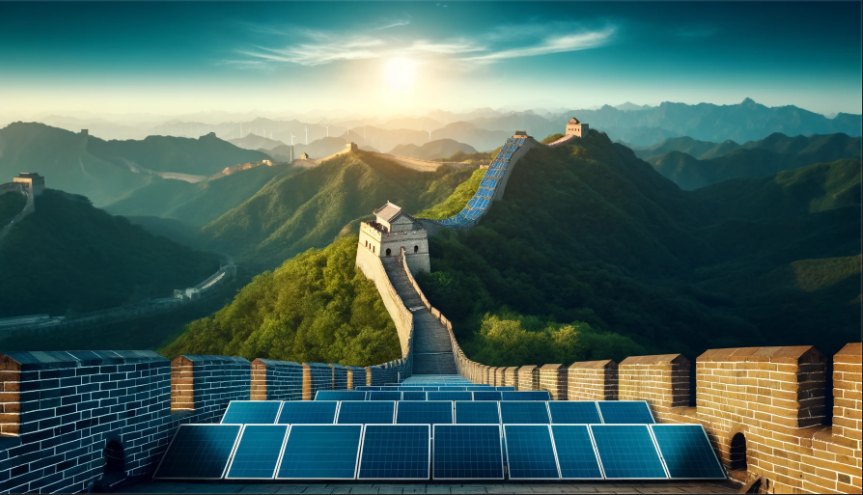Introduction
In a turn of historical irony, China, once subjugated by European powers during the “Century of Humiliation,” is now at the forefront of the global green energy revolution, potentially dictating terms in Europe’s backyard. As the world pivots to sustainable energy sources, China’s dominance in the production of critical green technologies—solar panels, wind turbines, and lithium-ion batteries—has placed it in a pivotal position to influence global markets and geopolitics alike. This blog post delves into the intricacies of this role reversal, examining how China leveraged its strategic foresight and governmental support to potentially steer the future of global energy.
The Genesis of China’s Green Dominance
Approximately 150 years after the Qing Dynasty fell prey to foreign imperialism, leveraging opium and gunboat diplomacy, China has emerged as a linchpin in the green technology sector. This transformation is rooted in a blend of state-led industrial policy, substantial financial subsidies, and a strategic focus on manufacturing key components of the renewable energy revolution.
China’s methodical approach to capturing the solar panel market epitomizes this shift. By producing 80% of the world’s solar panels, China has not only capitalized on its manufacturing prowess but has also significantly benefitted from state subsidies and tax breaks. Companies like Tongwei Solar have grown from national manufacturers to global leaders in photovoltaic cell production, with the company expecting to quadruple its production capacity by the end of 2024.
European Challenges and the Green Deal
In contrast, Europe’s ambitious Green Deal aims to reduce carbon emissions significantly by 2050. However, this initiative inadvertently opened doors for Chinese manufacturers who have outpaced their European counterparts. The disparity in production capacity and cost efficiencies has led to a scenario where European markets, much like in the 19th century, risk becoming dependent on external powers—this time for green technology instead of opium.
Governmental Influence and Strategic Subsidies
The Chinese government’s role in this sector cannot be overstated. With over $30 billion invested in the solar sector alone through 2023, Beijing has provided a fertile ground for companies to innovate and expand. This state-backed push has not gone unnoticed globally, with figures like U.S. Treasury Secretary Janet Yellen criticizing China for creating market distortions that disadvantage Western firms.
The Irony of Historical Reversal
Historically, Europe’s industrial powers once exploited China’s vast resources during the colonial era, a period marked by unequal treaties and economic subjugation. Today, the tables have turned. China’s strategic domination of green technologies essential for the energy transition might place Europe in a similarly dependent position as China was over a century ago.
The Battle for Raw Materials
Central to this dominance is the control over rare earth elements and other critical raw materials necessary for manufacturing green technologies. China controls a significant portion of these resources globally, which enhances its competitive edge and bargaining power in international markets. This control extends beyond mere market dynamics, influencing geopolitical and trade relationships.
European Response and Future Prospects
As Europe grapples with these challenges, the need for a strategic response has never been more urgent. The EU has initiated measures like the Critical Raw Materials Act to reduce dependency on Chinese imports. However, whether these measures will suffice to counterbalance China’s growing influence remains to be seen.
Conclusion
The narrative of China’s rise in the green technology sector is not just a story of economic prowess but also a geopolitical strategy that may redefine global power structures. Europe, aware of its precarious position, is striving to mitigate this new dependency through policy and innovation. Yet, the irony remains—a century and a half after the Opium Wars, the roles have reversed, with China potentially dictating the pace and direction of Europe’s green future.
FAQ Section
- What is the European Green Deal?
- The European Green Deal is a set of policy initiatives by the European Union with the aim of making Europe climate neutral by 2050. It includes ambitious targets for cutting carbon emissions, increasing renewable energy use, and improving energy efficiency across the continent.
- Why is China dominant in green technology?
- China’s dominance can be attributed to aggressive government subsidies, substantial investments in research and development, and stringent industrial policies that have supported the growth of domestic manufacturers in solar panels, electric vehicles, and battery technology.
- What are rare earth elements, and why are they important?
- Rare earth elements are a group of 17 minerals critical for manufacturing a variety of high-tech devices including smartphones, electric vehicles, wind turbines, and military equipment. Their importance stems from their varied uses in essential modern technologies.
- How is Europe responding to the challenge posed by China?
- Europe is responding by trying to diversify its sources of raw materials, investing in local production capabilities, and implementing policies such as the Critical Raw Materials Act to reduce dependency on Chinese imports.
- What could be the implications if Europe fails to reduce its dependency on China for green technology?
- Failure to reduce dependency could leave Europe vulnerable to political and economic pressures from China, potentially affecting everything from prices to supply chain stability and geopolitical leverage.

